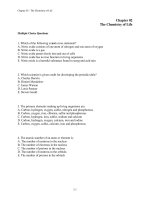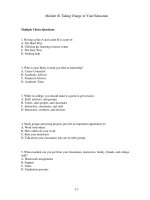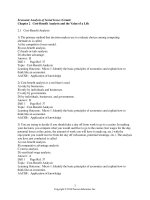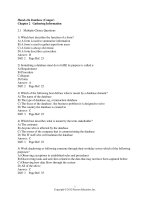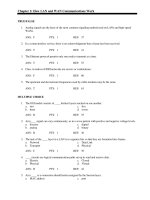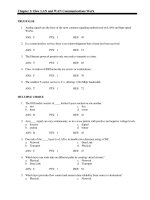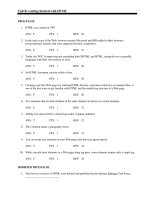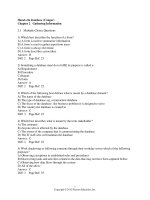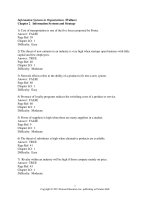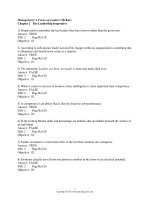Hands on networking fundamentals 1st edition michael palmer test bank
Bạn đang xem bản rút gọn của tài liệu. Xem và tải ngay bản đầy đủ của tài liệu tại đây (142.79 KB, 7 trang )
Chapter 2: How LAN and WAN Communications Work
TRUE/FALSE
1. Analog signals are the basis of the most common signaling method used on LANs and high-speed
WANs.
ANS: F
PTS: 1
REF: 37
2. In a connectionless service, there is no acknowledgment that a frame has been received.
ANS: T
PTS: 1
REF: 41
3. The Ethernet protocol permits only one node to transmit at a time.
ANS: T
PTS: 1
REF: 53
4. Class A nodes in FDDI networks are servers or workstations.
ANS: F
PTS: 1
REF: 60
5. The upstream and downstream frequencies used by cable modems may be the same.
ANS: T
PTS: 1
REF: 63
MULTIPLE CHOICE
1. The OSI model consists of ____ distinct layers stacked on one another.
a. two
c. five
b. three
d. seven
ANS: D
PTS: 1
REF: 35
2. A(n)____ signal can vary continuously, as in a wave pattern with positive and negative voltage levels.
a. discrete
c. digital
b. analog
d. binary
ANS: B
PTS: 1
REF: 36
3. The task of the ____ layer in a LAN is to organize bits so that they are formatted into frames.
a. Network
c. Data Link
b. Transport
d. Physical
ANS: C
PTS: 1
REF: 39
4. ____ circuits are logical communication paths set up to send and receive data.
a. Electric
c. Closed
b. Physical
d. Virtual
ANS: D
PTS: 1
REF: 42
5. A(n) ____ is a connection identification assigned by the Session layer.
a. MAC address
c. port
b. IP address
ANS: C
d. network id
PTS: 1
REF: 42
6. A Class ____ protocol within the Transport layer provides an option to recover lost packets in certain
situations.
a. 0
c. 2
b. 1
d. 3
ANS: D
PTS: 1
REF: 43
7. Two-way alternate (TWA) mode for dialog control is used in ____ communications.
a. simplex
c. half duplex
b. complex
d. full duplex
ANS: C
PTS: 1
REF: 43
8. ____ is a process that scrambles the data so that it cannot be read if intercepted by unauthorized users.
a. Encryption
c. Deciphering
b. Decryption
d. Decoding
ANS: A
PTS: 1
REF: 44
9. Computer programmers use the ____ layer to connect workstations to network services, such as
linking an application into electronic mail.
a. Presentation
c. Session
b. Application
d. Transport
ANS: B
PTS: 1
REF: 46
10. The term ____ refers to wrapping the information in one layer inside the information within the next
layer.
a. encase
c. encapsulate
b. enclose
d. envelope
ANS: C
PTS: 1
REF: 49
11. Information from one layer is transferred to the next by means of commands called ____.
a. primitives
c. primaries
b. pointers
d. messages
ANS: A
PTS: 1
REF: 50
12. Ethernet transport (the IEEE 802.3 specification), takes advantage of the ____ and star topologies.
a. bus
c. mesh
b. torus
d. tree
ANS: A
PTS: 1
REF: 53
13. The ____ field in an Ethernet frame synchronizes frame transmission and consists of an alternating
pattern of zeroes and ones.
a. data and pad
c. start of frame delimiter (SOF)
b. frame check sequence (FCS)
d. preamble
ANS: D
PTS: 1
REF: 54
14. Both standard 802.3 and Ethernet II can have ____ optional field(s) between the length or type field
and the data field
a. one
c. three
b. two
d. four
ANS: C
PTS: 1
REF: 55
15. The token ring transport method uses a physical ____ topology along with the logic of a ring topology.
a. bus
c. mesh
b. star
d. grid
ANS: B
PTS: 1
REF: 56
16. The ____ field of a token identifies the frame as a data frame or as a frame used for network
management, such as reporting network errors.
a. access control
c. frame status
b. frame check sequence
d. frame control
ANS: D
PTS: 1
REF: 57
17. If no broadcasts are detected from the active monitor or any one of the standby monitors, a ring goes
into a ____ condition.
a. signaling
c. messaging
b. beaconing
d. broadcasting
ANS: B
PTS: 1
REF: 58
18. ____ communications in FDDI networks are used for time-sensitive transmissions requiring
continuous transmission.
a. Synchronous
c. Modulated
b. Asynchronous
d. Amplified
ANS: A
PTS: 1
REF: 59
19. A(n) ____ line is a dedicated telephone line that can be used for data communications to connect two
different locations for continuous point-to-point communications.
a. DSL
c. T-carrier
b. LATA
d. IXC
ANS: C
PTS: 1
REF: 61
20. In the ____ switching technique, the bandwidth of communications medium is dynamically allocated
based on application need.
a. Time Division Multiple Access
c. circuit
b. Frequency Division Multiple Access
d. Statistical multiple access
ANS: D
PTS: 1
REF: 65
21. ____ switching establishes a dedicated circuit between the two transmitting nodes, but the circuit is a
logical connection and not a physical one.
a. Packet
c. Circuit
b. Frame
d. Message
ANS: A
COMPLETION
PTS: 1
REF: 66
1. LAN and WAN communications have been generally guided by a network communications model
called the ___________________________________ reference model.
ANS:
Open Systems Interconnection
OSI
Open Systems Interconnection (OSI)
OSI (Open Systems Interconnection)
PTS: 1
REF: 34
2. The ____________________ layer of the OSI model controls the passage of packets along routes on
the network.
ANS: Network
PTS: 1
REF: 41
3. The Microsoft Windows ____________________ is a service that makes one computer visible to
another for access through the network.
ANS: redirector
PTS: 1
REF: 46
4. ____________________ is the process of checking communication media for a specific voltage level
indicating the presence of a data-carrying signal.
ANS: Carrier sense
PTS: 1
REF: 53
5. The ________________________________________ switching technique divides channels into
distinct time slots.
ANS:
Time Division Multiple Access
TDMA
Time Division Multiple Access (TDMA)
TDMA (Time Division Multiple Access)
PTS: 1
REF: 65
MATCHING
Match each term with the correct statement below.
a. discovery
f.
b. peer protocols
g.
c. digital signal
h.
d. message switching
i.
e. Service access point (SAP)
frame
packet radio
point of presence (POP)
simplex communications
1.
2.
3.
4.
5.
6.
7.
8.
9.
uses distinct voltages to generate binary ones or zeroes.
discrete unit of data containing control and address information corresponding to OSI Data Link layer.
process by which Network layer constantly gathers metrics about the location of networks and nodes.
allows a signal to travel in only one direction on a medium.
enable an OSI layer on a sending node to communicate with the same layer on the receiving node.
enables Network layer to determine which network process at the destination should accept a frame.
a junction at which LATA lines are connected to IXC lines.
form of wireless WAN communication that takes place at very high radio frequencies.
uses a store-and-forward communication method to transmit data from sending to receiving node.
1.
2.
3.
4.
5.
6.
7.
8.
9.
ANS:
ANS:
ANS:
ANS:
ANS:
ANS:
ANS:
ANS:
ANS:
C
F
A
I
B
E
H
G
D
PTS:
PTS:
PTS:
PTS:
PTS:
PTS:
PTS:
PTS:
PTS:
1
1
1
1
1
1
1
1
1
REF:
REF:
REF:
REF:
REF:
REF:
REF:
REF:
REF:
37
39
42
44
49
55
60
64
66
SHORT ANSWER
1. Provide a high-level description of the bottom, middle, and top layers of the OSI model.
ANS:
The bottom layers perform functions, such as constructing frames and transmitting packet-containing
signals, related to physical communications. The middle layers coordinate network communications
between nodes, ensuring that a communication session continues without interruptions or errors, for
example. The top layers perform work that directly affects software applications and data presentation,
including data formatting, encryption, and data and file transfer management. Taken together, the set
of layers is called a stack.
PTS: 1
REF: 36
2. What are electromagnetic interference (EMI) and radio frequency interference (RFI)?
ANS:
Electromagnetic interference (EMI) and radio frequency interference (RFI) are two sources of Physical
layer interference.EMI is caused by magnetic force fields that are generated by electrical devices such
as fans, elevator motors, portable heaters, and air-conditioning units. RFI is caused by electrical
devices that emit radio waves at the same frequency used by network signal transmissions. These
transmissions include cable TV components, radio and television stations, nearby amateur radio
operators, ballast devices in fluorescent lights, inexpensively built computer or TV equipment, and CB
radios.
PTS: 1
REF: 38
3. What is the role of the media access control (MAC) sublayer of the Data Link layer?
ANS:
The MAC sublayer examines the physical address or device address—sometimes called the MAC
address—information contained in each frame.For example, the MAC sublayer on a workstation
examines each frame received by the workstation and sends the frame to the next higher layer, if the
address matches. The frame is discarded if the address is not a match. The MAC sublayer also
regulates how multiple devices share communications on the same network.
PTS: 1
REF: 39
4. Explain how TWS (two-way simultaneous) dialog control and buffering enable full duplex
communications.
ANS:
TWS enables full duplex communications in which the network interface can send and receive at the
same time, because there are two channels created over the same medium, one for receiving and one
for sending. Besides the TWS capability, full duplex is possible because of buffering at the network
interface. Buffering means that the NIC is equipped with memory to temporarily store information that
it is not currently processing.
PTS: 1
REF: 44
5. Describe the relationship between the service data unit (SDU) and protocol data unit (PDU).
ANS:
At each OSI layer,an SDU is encapsulated with control and transfer information to form a PDU. After
the PDU is formed at a particular layer on computer A, for instance, it is then sent to the same layer on
computer B. Also, if the layered communications are going down the stack on computer A, for
example, then the PDU is sent to the next lower layer in the stack. The control and transfer information
is stripped out of the PDU to leave only the SDU. That layer then adds control and transfer
information.
PTS: 1
REF: 50
6. What is a Request for Comment (RFC)?
ANS:
An RFC is a document prepared and distributed by any individual or group as a way to further
networking, Internet, and computer communications. RFCs help ensure that network standards and
conventions are provided so one network can talk to another. Every RFC is assigned a number to
distinguish it from other RFCs and to provide a way to track it. Older RFCs are sometimes clarified,
built upon, or replaced by newer ones. RFCs build cooperation in a community of equals and play a
significant role in advancing network technologies.
PTS: 1
REF: 52
7. Describe the role of the active monitor in a token ring network.
ANS:
Each token ring network designates one node as the active monitor. Usually this is the first station
recognized when the network is brought up. The active monitor is responsible for packet timing on the
network and for issuing new token frames if problems occur.Every few seconds, the active monitor
broadcasts a MAC sublayer frame to show it is functioning properly. A broadcast frame or broadcast
packet is one that is sent to all points on the network. The other workstation nodes are standby
monitors.Periodically, they broadcast frames called “standby monitor present” frames to show they are
working normally and are available to replace the active monitor should it malfunction.
PTS: 1
REF: 57
8. Compare and contrast FDDI to the token ring access method.
ANS:
FDDI is similar to the token ring access method because it uses token passing for network
communications. It differs from standard token ring in that it uses a timed token access method. An
FDDI token travels along the network ring from node to node. If a node does not need to transmit data,
it picks up the token and sends it to the next node. If the node possessing the token does need to
transmit, it can send as many frames as desired for a fixed amount of time, called the target token
rotation time (TTRT). Because FDDI uses a timed token method, it is possible for several frames from
several nodes to be on the network at a given time, providing high-capacity communications.
PTS: 1
REF: 59
9. Describe the role of the headend in the star topology of a Cable TV WAN.
ANS:
The focal point in the star is the headend, which is the central receiving point for signals from various
sources, including satellite, other major cable sources, and local television sources. The headend is a
grouping of antennas, cable connections, microwave towers, and satellite dishes, and it distills all
incoming signal sources and transfers them to remote distribution centers through trunk lines.
PTS: 1
REF: 62
10. Describe the topology of wireless WANs using radio communications.
ANS:
The topology of radio communications requires connecting a LAN to a wireless bridge or switch, for
example, which in turn is connected to an antenna. The antenna transmits a radio wave to a distant
antenna, which is also connected to a bridge, switch, or router that receives packets and places them on
the local LAN. This type of communications is called packet radio and takes place at very high radio
frequencies.
PTS: 1
REF: 64
